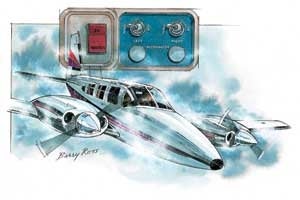One Saturday morning in the early 1990s my six-year-old son and I headed out for a little IFR adventure. Ceilings were 700-900 feet, and the winds were mild. In Topeka, Kansas, we have the benefit of two controlled airports. Billard has a very active instruction and general aviation program, and Forbes is a former Air Force base with two runways; the longer is 12,800 feet. You have to try to miss it. There are numerous instrument approaches at the two airports that afford excellent opportunities to practice approaches on such a day.
My son and I unhangered our Seneca, performed a reasonably thorough preflight and then set about getting started for our adventure. I have always prided myself with being prepared for unforeseen situations, and carried all the requisite charts, a handheld radio and a survival kit in my flight bag. We were filed with Kansas City Center for a “round robin” from Billard to Forbes with multiple instrument approaches. After we were cleared for our plans, I performed the run up and checklist. My son was in a great mood and I was happy to have him with me on such a nice cloudy morning. We conversed as I went through the checklist, and then we were ready for departure.
After takeoff, we were vectored to the Forbes initial approach fix NDB. Billard and Forbes are only a few miles apart, so the trip takes very little time. My approach plan was for the ILS 31 at Forbes, and after the missed approach I would return to Billard for the VOR 22, ILS 13 and finish with the LOC back course to 31. A good workout for the day.
We climbed out without incident and were in the soup at 700 feet. We were vectored on a southwesterly course and continued the climb to 3,000 feet. Soon we were given our inbound turn to join the localizer for the ILS 31 at Forbes. Then things started to hit the fan.
I first noticed that the comm radios seemed to sputter and flicker. The VOR and localizer needles flickered as well. Then they were okay. I called center, all was okay. But not for long. With very little warning the radios went dead, VORs dead, all comm dead. Lights out, complete electrical failure. It is remarkable how calm things seem when you are on the edge of disaster. The engines were just happily purring along as if nothing were wrong. I had an incredulous sense of wonderment, fear, shock and exhilaration. I also felt that cold creeping sense of panic at the base of my neck like someone pouring cold water down my spine.
Meanwhile my dear son was humming and reading his little book. Having no intent to frighten him, I just kept my mouth shut.
First I tried to set the transponder to 7600. No luck because it was dead. Then I reached for my handheld radio which was neatly put away in my flight bag in the back seat. Whoops, the autopilot was down; no help there to watch the altitude. Had to concentrate on keeping the airplane level. Let’s see, what instruments are electric and which are still functioning? Prioritizing, I had to leave the search for the handheld radio for a bit. I was flying into a busy airport environment with no communications in IMC. I urgently thought through my priorities. Fly the airplane, maintain the last course, fly the last fix, and I figured that I was very close to the final approach course if I descended. I looked up a “no glide- slope” decision height and found that it would be 1,460 feet msl, 400 feet agl. Hopefully, this would get me out of the clouds. Still could not get the handheld out of the bag and assembled.
What the heck was causing this mess anyway? Whoops, watch that attitude indicator.
I descended to about 1,600 feet msl and had the airport in sight. Amazingly, I was almost exactly on the runway center line. My workload dropped a little, and I finally got the handheld going. I radioed the situation to the tower and asked if they saw any lights on the airplane. Answer was no. How could this be? I touched down visibly shaken and taxied off the runway.
Then it hit me. How could an airplane with two functioning engines and two alternators have a complete electrical failure? I looked at the alternator switches and guess what? Both were off and had been since some repairs were performed earlier that week on the electrical system. I flipped them on and presto, full electricity. The tower asked if I wanted to taxi to park, but instead I flew back to Billard, shaken and scud running. In the early 1990s I had owned my 1977 Piper Seneca for a couple of years with a partner who used it in charter and instruction. The airplane flew about 300 hours a year and had been used in all weather. This moderate amount of flying resulted in fairly regular but sometimes unexpected repairs and service. Apparently, some repairs had been done and the alternators turned off. In my haste to get into the air, I had failed to carefully confirm that they were on and functional while carrying on a conversation with my son.
I learned several critical lessons that morning. First, perform a careful checklist with no outside interruptions. Second, if bad things happen, stay cool and fly the airplane. Bad things can get worse. Third, know the emergency procedures. Fourth, keep a handheld assembled, with good batteries, within reach in IFR conditions. Last, hope for good luck.
To see more of Barry Ross’s aviation art, go to www.barryrossart.com
